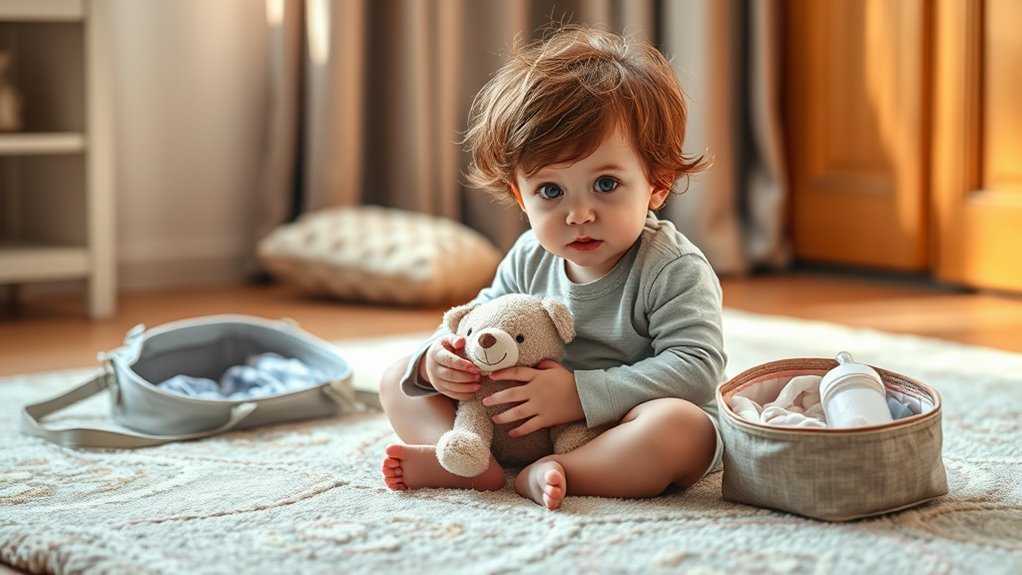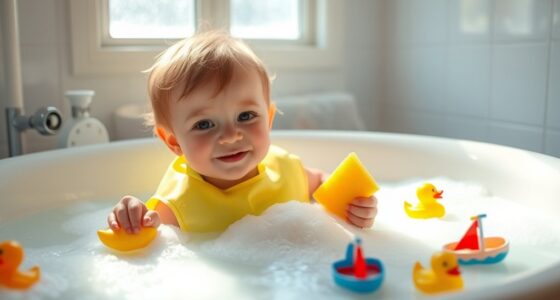Preparing your toddler for a new sibling means talking openly about the changes and involve them in the journey. Use simple explanations, show excitement, and include your child in nursery preparations. Keep routines consistent and offer plenty of special attention to help them feel secure. Introducing the baby gradually and emphasizing their continued importance eases feelings of jealousy. If you want to learn more about making this progression seamless, you’ll find helpful tips for fostering a strong bond ahead.
Key Takeaways
- Address your toddler’s feelings openly to reduce jealousy and foster emotional security.
- Involve them in pregnancy preparations and nursery setup to build excitement and a sense of control.
- Use age-appropriate explanations about the baby and body changes to prepare them for the new sibling.
- Maintain consistent routines and special attention to provide stability amid changes.
- Foster bonding through shared activities, positive reinforcement, and emphasizing their ongoing love and importance.
Talking About the New Arrival

Have you started talking to your toddler about the upcoming new sibling? It’s important to address their feelings early, helping them understand what to expect. Explaining that a new baby is coming can reduce feelings of uncertainty and jealousy. Be honest and simple, emphasizing that they are still loved and special. Discussing birth order can also help your toddler see their new role in the family, easing worries about sibling rivalry. They might wonder if they’ll still be the “big kid” or if they’ll need to share attention. Reassure them that everyone has unique qualities and that their place in the family remains important. Open conversations facilitate confidence and create a smoother transition, helping your toddler feel included and secure about the new addition. Incorporating family dynamics into your discussions can prepare your child for changes and foster a sense of belonging. Understanding home theatre technology can also make your child’s environment more engaging and comforting during this time. Recognizing emotional readiness is essential to ensure your child feels prepared to welcome their new sibling.
Involving Your Toddler in the Pregnancy Journey
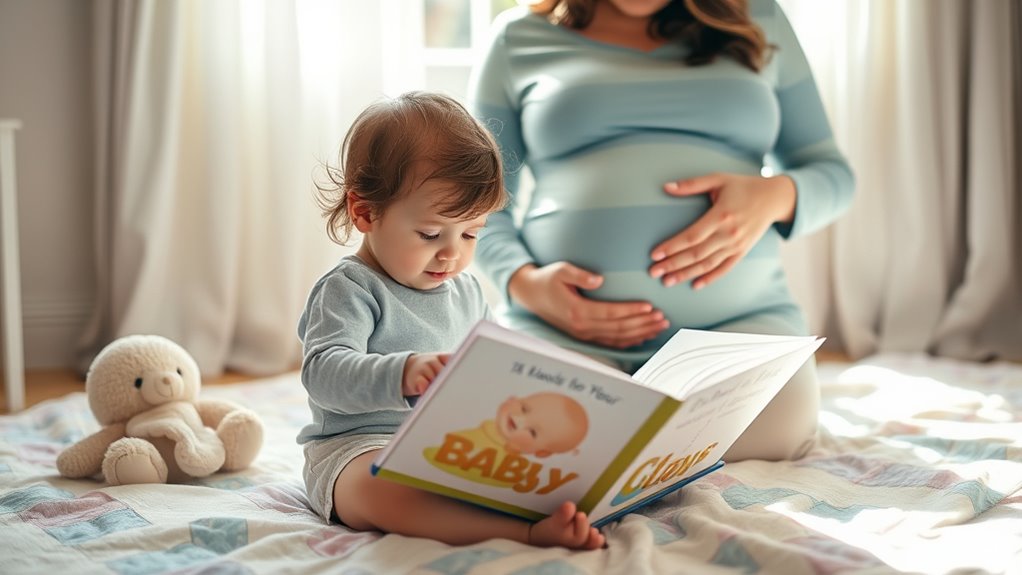
You can start by sharing the pregnancy news with your toddler in a simple, joyful way. Involve them in preparing for the baby’s arrival, like setting up the nursery or choosing clothes. These actions help your little one feel included and excited about the new family member. Introducing digital menu solutions can also be a fun way to teach older children about technology and new innovations. Additionally, exploring animated movies that touch hearts can be a comforting way to help your toddler understand and emotionally connect with the upcoming changes. Understanding voice over script optimization can assist in creating engaging stories or explanations that resonate with your child.
Share Pregnancy News
Sharing the news of your pregnancy with your toddler can be a fun and meaningful experience when approached thoughtfully. You might start by telling them in a simple, joyful way, like showing a tiny pair of shoes or a special nursery decor piece. Keep it positive and age-appropriate, emphasizing how exciting it will be to have a new sibling. Consider giving a small sibling gift, like a stuffed animal or a book about becoming a big brother or sister, to make the moment memorable. This helps your toddler feel involved and special. Remember, your enthusiasm will help them share in your happiness and begin to understand their new role in the family. Sharing early builds excitement and eases any feelings of confusion or jealousy. Introducing the idea of a juice cleanse or detox in a healthy, age-appropriate way can also help them understand changes in routine. Additionally, using simple language about the pregnancy can foster their understanding and comfort. Explaining the importance of hormonal balance in a way they can grasp can also support their understanding of body changes.
Include Toddler in Preparations
Involving your toddler in pregnancy preparations can help them feel included and excited about the upcoming addition to the family. Talk openly about what to expect, setting realistic toddler expectations about a new sibling. Let your child help pick out baby clothes or decorate the nursery, giving them a sense of ownership in the process. This involvement can reduce feelings of jealousy or sibling rivalry later on. When you include your toddler, they’re more likely to view the new baby as a positive addition rather than a threat. Keep communication simple and comforting, emphasizing that they’re still loved and important. Creating these shared experiences helps foster a bond before the baby arrives and eases the transition for your toddler. Understanding child development stages can help tailor your approach to their emotional needs during this time and ensure you address their emotional needs effectively. Additionally, recognizing the importance of supporting children through divorce can prepare you to address any emotional reactions your toddler may have during family changes.
Preparing Your Child’s Environment for the New Baby
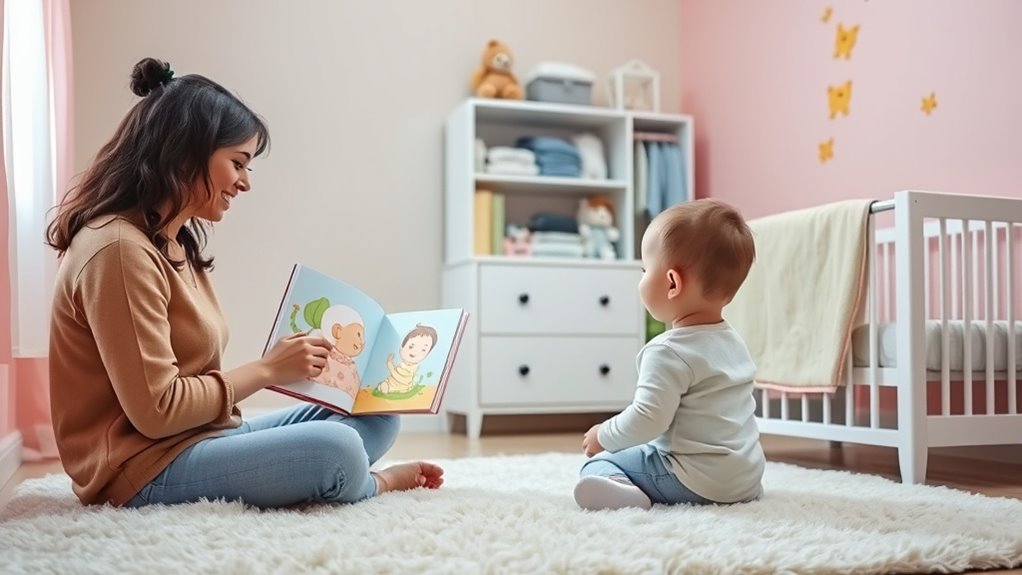
Preparing your child’s environment for a new baby involves more than just setting up a crib; it’s about creating a space that reassures your toddler and promotes positive feelings about the upcoming change. Focus on nursery decoration that feels welcoming and familiar, incorporating your child’s favorite colors or themes to make it their own. Keep some of their belongings visible and accessible to maintain a sense of stability. Arrange for sibling gift prep, like special presents or keepsakes, so your child feels included and excited. Consider adding a cozy reading nook or a small corner with favorite toys to help them feel comforted. Learning about somatic therapy techniques can also be helpful if you’re considering strategies to help your toddler process their feelings about the new sibling. These thoughtful touches help your toddler see the new space as a positive, shared environment that’s all about their growth and emotional well-being.
Setting Realistic Expectations and Addressing Feelings
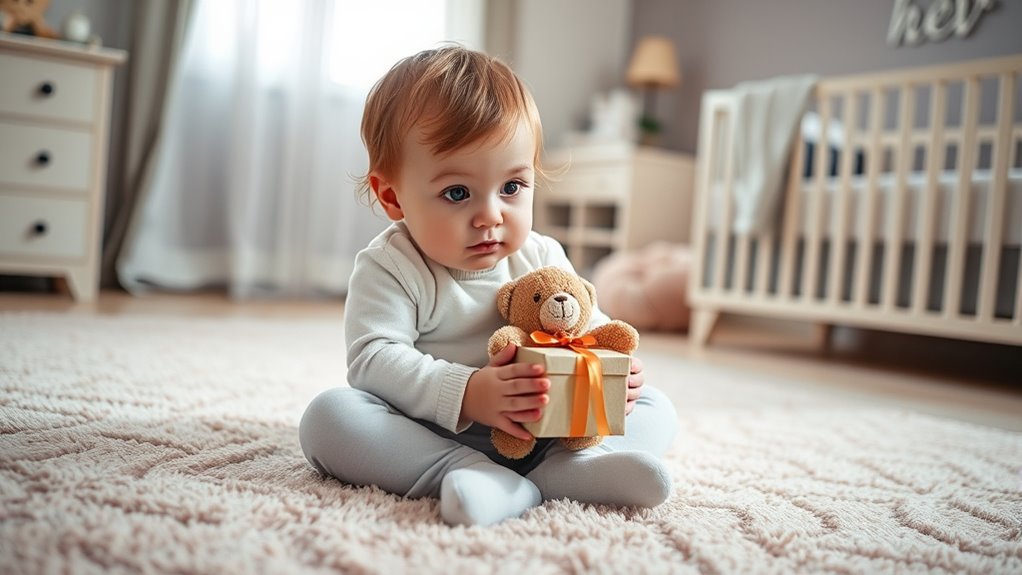
You should openly acknowledge your toddler’s feelings about the new baby, so they feel heard and understood. Setting clear boundaries helps them know what’s expected and reduces confusion or jealousy. By being honest and consistent, you create a safe space for your child’s emotions to develop healthily. Recognizing the importance of emotional connection can also support your child’s adjustment during this transitional period. Additionally, understanding fatherhood impact highlighted in inspirational quotes can inspire you to foster a nurturing environment during this time. Incorporating simple plant care routines can also help create a calming environment that benefits the whole family.
Clarify Feelings Openly
Because toddlers are still learning to understand complex emotions, openly discussing feelings helps set realistic expectations and reduces confusion. When you clarify feelings, you encourage emotional expression and validate their emotions, making them feel understood. This helps your child navigate new experiences like a sibling’s arrival with confidence. Additionally, practicing mindful decluttering strategies can create a calmer environment, making transitions easier for your toddler.
Establish Clear Boundaries
Establishing clear boundaries is essential to helping your toddler understand their new role and manage expectations during this change. Consistent discipline strategies let your child know what behaviors are acceptable, reducing confusion and frustration. Reinforce routines for sleep and daily activities to create stability amid the upheaval. Be firm but gentle when setting limits on behaviors like seeking attention or acting out, explaining boundaries in age-appropriate ways. This consistency helps your toddler feel secure and understand what’s expected of them as they adjust to a new sibling. Remember, boundaries aren’t about restriction but about creating a safe environment where your child can express feelings and learn appropriate responses as they navigate this transition. Incorporating behavior management techniques rooted in understanding can further support their emotional development during this period.
Planning the First Meeting With the Baby

When planning your toddler’s first meeting with the new baby, it’s important to create a calm and positive environment. Keep the atmosphere relaxed to help ease any initial nerves and reduce sibling rivalry fears. Consider visiting the hospital beforehand so your toddler knows what to expect and can see the baby in a familiar setting. Bring a special toy or blanket to introduce the baby’s scent and comfort your toddler. Remember, the age gap can influence their reaction—older toddlers may understand more but feel jealous, while younger ones might need simple reassurance. To set the stage, prepare your toddler with gentle explanations and patience, making sure they feel included and loved during this special moment.
Maintaining Routine and Providing Special Attention
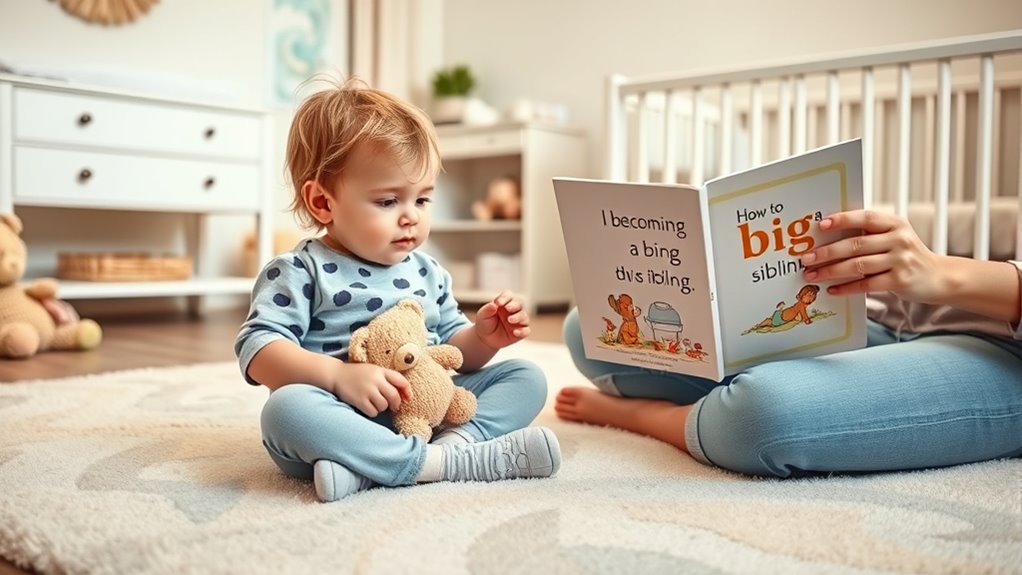
To help your toddler adjust to the new family dynamic, it’s essential to maintain their usual routines as much as possible. Consistent schedules give them a sense of security and support toddler independence. Introduce new routines gradually to help them adapt without feeling overwhelmed. To keep things engaging, try activities like special one-on-one time or quiet moments with you. This reassures them that they still matter. Here’s a simple way to visualize some changes:
| Current Routine | New Routine Adaptation |
|---|---|
| Morning play | Include the baby in playtime |
| Snack time | Offer favorite snacks with the baby nearby |
| Bedtime stories | Read together, praising independence |
Sticking to familiar routines while introducing gentle new ones helps your toddler feel secure and loved.
Encouraging a Bond Between Siblings
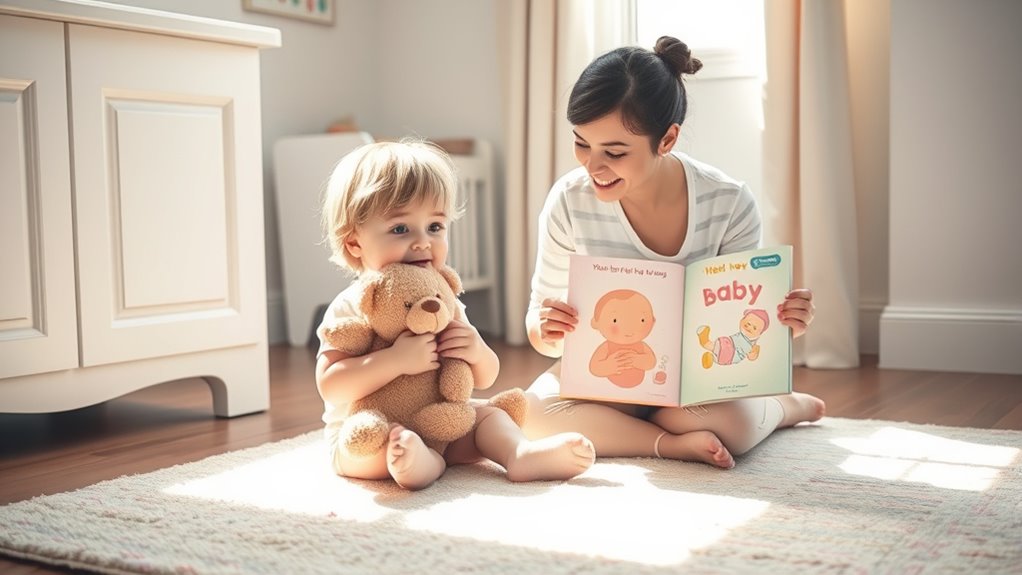
Fostering a positive bond between your toddler and new sibling starts with creating opportunities for shared experiences. Encourage activities that promote teamwork and connection, like reading stories together or playing simple games. This helps your toddler feel included and builds a foundation of trust. To prevent sibling rivalry, teach your child about sharing toys and taking turns, emphasizing cooperation over competition. Celebrate small moments of kindness and support to reinforce positive interactions. Be patient as your toddler adjusts, and avoid forcing closeness. Instead, gently guide them toward understanding and empathy, making the bond natural and enjoyable. Remember, fostering a loving relationship takes time, patience, and consistent encouragement. With these steps, your children can develop a strong, supportive sibling connection.
Frequently Asked Questions
How Can I Help My Toddler Adjust to Sharing Attention?
You can help your toddler adjust to sharing attention by establishing sharing routines, like taking turns with toys or activities, to make sharing feel natural. Encourage fostering independence by giving your toddler small responsibilities, such as choosing their clothes or helping with simple tasks. Praise their efforts to share and be patient as they learn. Consistent routines and positive reinforcement will build their confidence and ease the progression.
What Are Signs My Toddler Is Feeling Jealous or Overwhelmed?
You might notice jealousy cues like your toddler clinging more, acting out, or withdrawing. Emotional signs include sadness, irritability, or regression in behavior. If they seem overwhelmed, they may ask for extra cuddles or show increased tantrums. Pay attention to these signals, and respond with reassurance and patience. Offering your attention and validating their feelings helps them process their emotions and reduces feelings of jealousy or overwhelm.
How Do I Explain the Baby’s Arrival if My Toddler Is Very Young?
You can explain the baby’s arrival simply by telling your toddler that the baby has special needs and will require lots of love and care. Use gentle words and pictures to show how the baby will be a new friend to bond with, helping your toddler understand their role in sibling bonding. Reassure them that they are still loved and important, making the progression easier for everyone.
When Should I Start Preparing My Toddler for the Baby’s Birth?
You should start preparing your toddler about 4 to 6 weeks before the baby’s arrival. Use age-appropriate books and visual aids to help them understand what’s happening. Talk gently and involve them in preparations to make them feel included. Keep explanations simple and positive, showing excitement about their new role as a big sibling. This approach helps ease any anxiety and fosters a positive attitude toward the new family member.
How Can I Involve My Toddler in Caring for the New Sibling?
You can involve your toddler in caring for the new sibling by encouraging toddler bonding through simple tasks like fetching diapers or choosing clothes. Give them special responsibilities, such as holding the baby’s hand during diaper changes, to foster a sense of involvement. Engaging your toddler in these activities promotes bonding and helps them feel included, making the progression smoother for everyone.
Conclusion
Remember, preparing your toddler for a new sibling is like planting a garden. With patience, consistent care, and love, you nurture their feelings and set the stage for a beautiful bond to blossom. I once saw a little boy gently hold his newborn sister, eyes shining with pride—proof that, with the right preparation, your child will grow into a caring and confident older sibling. Keep nurturing those roots, and watch your family flourish.
